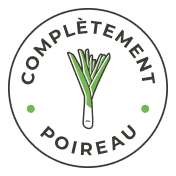Pasta fan? Forget about already made ones at the grocery store! We give you the best recipe and explain how to make your homemade pastas without being so complicated.
Ingredients needed to make homemade pastas
To make about 4 portions, you’ll need the following ingredients :
- 2 1/2 cups of all-use flour
- A pinch of salt
- 4 large eggs
- 15 ml (1 tablespoon) of olive oil
Tips: Always keep a bit of flour under the hand. This way, if your mixture lacks some you’ll easily be able to add it. It’ll also be useful to avoid the dough from being glued all over.

Step 1: Preparer the mixture
Mix flour with a pinch of salt, then set over a work surface or in a bowl while digging a hole in its center. Break eggs and add oil in this very hole.

Step 2: Mix liquids with flour
Then whisk eggs and oil with a fork and gradually add flour. When it’s harder to whisk with a fork, continue with your hands.
Tips: It’s possible that 2 1/2 cups could be too much for your mixture. Its’ normal, the amount depends of the moisture of your flour and the size of the eggs. Don’t try to add all flour if the mixture is already enough and works out well.

Step 3: Knead the dough
10 minutes, it’s all you need to knead the dough. Fold the dough over itselves and sprinkle a bit of flour over if it’s starts to stick to your work surface. When th dough is smooth and kind of elastic, it’s time to stop kneading!

Step 4: Cover the dough and cool down
Before lowering the dough with your tools (rolling mill) or with a rolling pin, cover it with a plastic wrap and cool down for 30 minutes. It’s that much simple!

Step 5: Lower the dough
Rolling pin
To finely and easily lower the dough:
- Spread the rolling pin over the dough.
- Turn it from a quarter turn before rolling the pin for a second time.
- Repeat those steps until obtaining a very thin dough.
- Flour the dough if needed to avoid it from sticking to the surface or the pin.
Pastas device
If you have a manual or electric rolling mill set over a mixer like ones of the KitchenAid, select the larger space to start lowering the dough.
- Flour dough and lower lightly to be easily able to be set in the machine.
- Flour the dough and fold it into 3 while putting weight on it to lower.
- Repeat 2 first steps 3 times.
- Flour dough and reduce its thickness by changing the space between both rolls of the machine with the selector.
- Set the dough only one time for each layer.
To obtain results for a good thickness which will cook well, refer yourself to the maker’s instruction.
Tips: With an electric rolling mill, always work at the lowest speed.

Step 6: Slice dough
No matter if you slice pastas with a machine or a knife, always flour to avoid sticking together.

Step 7: Cook fresh pastas
Fresh pastas cooks faster than commercial ones bought at the grocery store. However, the ways stays the same : soak into salted boiling water. Calculate 2 to 4 minutes based on the thickness or the type of pastas you made. The best way to know if pastas are cooked? Taste it simply 😊

Now that you know the best recipes for homemade pasta, we invite you to try it out with one of the many recipes available on our website!




